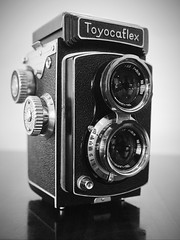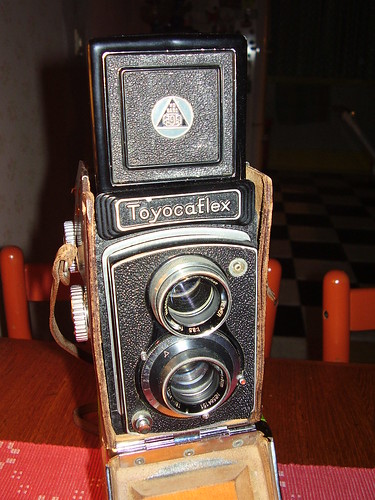Toyocaflex
The Toyocaflex[1] is a Japanese 6×6 TLR camera produced by Tougodo from early 1955. It is based on the Rolleicord and so is very similar to other Rolleicord copies, like the Yashica-D. So similar in fact, that many Japanese TLRs, such as the Starflex[2] and Skyflex[3] are considered to be rebadged versions of the Toyocaflex.
Contents
Versions and operation
There seem to be at least two versions of the Toyocaflex. The earlier one lacks a bayonet mount for a filter or hood. The later one accepts bay I filters and accessories (like sun shades). Both have Tri-Lausar 8cm/3.5 lenses for both the taking and viewing lens. Tri-Lausars are three-element lenses made by Tomioka. They do not enjoy a great reputation on the web[4]. There is a focusing knob on the right side of the camera. The distance scale is in feet only, as was common for Japanese cameras and lenses of the period. Opposite the distance scale is a depth-of-field table. On that same right side is an winding knob that also advances a mechanical frame counter. The shutter is cocked by a lever at a 10 o'clock position.[5].
Speeds and aperture
Speeds and aperture are set by levers. Speeds range from B, 1-1/300s on an unmarked or Rectus shutter. Apertures can be set from f/3.5 to 22.

|
| image by Jeff Wyonch (Image rights) |

|
| w bay I filter image by Colton Allen (Image rights) |
Notes
- ↑ "Toyoca" is certainly the contraction of Toyohashi — Tougodo's hometown — and Camera.
- ↑ McKeown, p.902.
- ↑ Skyflex TLR topic at the Photo.net Forums
- ↑ Peter Williams, "The New Yashica TLR FAQ"; and "Yashica: A Twin-Lens Reflex Camera"; both at Robert Monaghan's Medium-Format site (archived). Most of the arguments given however, seem to come down to a similarity in sound (in English) between Tri-Lausar and lousy: photographically not very convincing.
- ↑ Or anyway on the later version; on the earlier version, the shutter is set by lever under the taking lens
Bibliography
- Asahi Camera (アサヒカメラ) editorial staff. Shōwa 10–40nen kōkoku ni miru kokusan kamera no rekishi (昭和10–40年広告にみる国産カメラの歴史, Japanese camera history as seen in advertisements, 1935–1965). Tokyo: Asahi Shinbunsha, 1994. ISBN 4-02-330312-7. Items 627–8 and 1389–91. (See also the advertisements for items 629–30
- Lewis, Gordon, ed. The History of the Japanese Camera. Rochester, N.Y.: George Eastman House, International Museum of Photography & Film, 1991. ISBN 0-935398-17-1 (paper), 0-935398-16-3 (hard). P.88 (brief mention only, spelled "Toyokaflex I" by mistake).
- McKeown, James M. and Joan C. McKeown's Price Guide to Antique and Classic Cameras, 12th Edition, 2005-2006. USA, Centennial Photo Service, 2004. ISBN 0-931838-40-1 (hardcover). ISBN 0-931838-41-X (softcover). P.932.
- Sugiyama, Kōichi (杉山浩一); Naoi, Hiroaki (直井浩明); Bullock, John R. The Collector's Guide to Japanese Cameras. 国産カメラ図鑑 (Kokusan kamera zukan). Tokyo: Asahi Sonorama, 1985. ISBN 4-257-03187-5. Items 2269–72.
- Watakushi no ni-gan-refu kamera-ten (私の二眼レフカメラ展, Exhibition of twin lens reflex cameras). Tokyo: JCII Camera Museum, 1992. (Exhibition catalogue, no ISBN number.) P. 31.
Links
General links
In English:
- Tougodo TLR cameras at Barry Toogood's tlr-cameras.com
- Skyflex at Westfordcomp (archived)
- Skyflex in flickr Camerawiki pool
In French:
- Toyocaflex in Lionel's 35mm-compact.com
- Toyocaflex in a comparison of various TLRs, at Pierre Dirapon's website
In Japanese:
- Toyocaflex IB at Doraku Oyaji no Kamera Koheya (archive.org)
- Toyocaflex II at Otowa no nigan-refu (archived)
- Toyocaflex IIB at Aya's Camera
Repair notes
- Skyflex/Toyocaflex shutter repair in a post at photo.net
